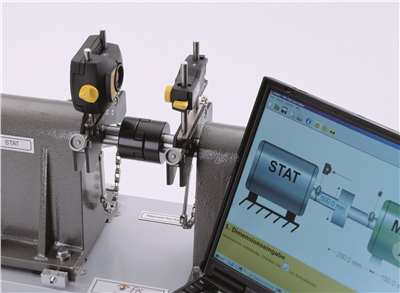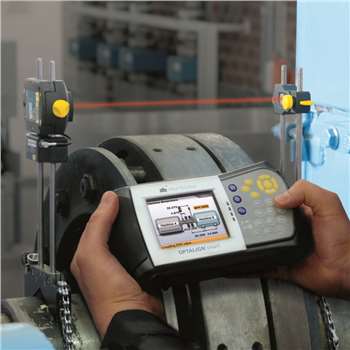
Article - Laser Alignment and Soft Foot
Author - Andrew Dahlitz Technical Services Technician
Laser Alignment and Soft Foot
Author - Andrew Dahlitz Technical Services Technician
Laser alignment of power transmission drives can be a maintenance necessity for viable plant operation. With the ever increasing cost of power, the savings that can be realized in drive efficiency can be substantial, particularly when considering multiple drives across a site. Misaligned drive components cause the motor to draw more amps. This unnecessary power consumption can be significantly reduced by decreasing the misalignment.
Power savings are a secondary benefit of accurate alignment. The primary benefit is extending the operating life of the machinery. Bearings and power transmission drive components, such as gearboxes, electric motors, pumps, couplings, v-belts, pulleys, industrial brakes, chain and sprockets, will operate more effectively with a reduction in noise emission, vibration, and operating temperatures. Therefore, this provides an extended lifetime of the particular drive component.
The advantage of an accurate laser alignment will extend the Mean Time Between Failures (MTBF). This reduces costly downtime, which in turn reduces maintenance costs. Traditional alignment methods, although still commonly in use, do not always produce the accuracy required by today’s precision machinery. Basic alignment methods include the use of a straight edge and feeler gauge. This type of alignment may be simple and fast, however, it is highly unlikely to achieve the accuracy required. An alternative is to use dial indicators, which offer a higher degree of accuracy. However, these still pose difficulties depending on mounting point availability and access, dial indicator sag, and the requirement of specialist operators.
 A laser shaft alignment tool facilitates a
quicker and more accurate laser alignment than traditional methods. However,
even when using more accurate technology, such as laser equipment, there is a
broad range of conditions and influencing factors that may exist. This means
that certain alignment processes need to be adhered to, and not ignored.
A laser shaft alignment tool facilitates a
quicker and more accurate laser alignment than traditional methods. However,
even when using more accurate technology, such as laser equipment, there is a
broad range of conditions and influencing factors that may exist. This means
that certain alignment processes need to be adhered to, and not ignored.
Soft foot is one important influencing factor that may be overlooked when trying to achieve accurate laser alignment. Soft foot is a term used to describe distortion present under a machine, which is evident when either the machine base is warped, or when one or more feet of the machine differ in height. If soft foot is not eliminated, or, at the very least, reduced to an acceptable level, it can create stress on bearings and other components and significantly reduce the life of the machine. If left undiagnosed and untreated, soft foot can considerably lengthen the laser alignment process, causing inconsistencies with results and frustration for the operator of the alignment equipment.
Soft foot should be checked via a deflection method at each foot and shimmed accordingly. It can often quickly be identified with all bolts loose. Deflection tests should not be performed prior to a rough alignment of the drive, as the coupling may influence the results. Be aware that it is necessary to re-check all bolts following inclusion of any shims applied in order to correct soft foot. This check should confirm if any adjacent machine foot has been detected. There are two conditions of soft foot that may be diagnosed.
- Parallel soft foot is where one or more mounting points, or feet, are too short, or one base plate-mounting pad is not level with the other three. Parallel soft foot is also caused when shims under one of the feet are the wrong height. This is corrected by placing a shim under one of the shorter feet.
- Angular soft foot is where the bottom of one mounting point, or foot, is not parallel with the base and is only partly in contact with the mounting base. This should be measured with a feeler gauge, and built up with the appropriate thickness shims, taking care to only fill the gap as required.
Often, both parallel and angular soft foot is present under the same foot. This means that attention needs to be given to defining the type of soft foot condition present, prior to shimming accordingly. It should also be noted that soft foot can be induced during the alignment process, or during previous alignment. A common mistake can be to place a shim of incorrect thickness under a foot, inadvertently creating a difference in height. It is important to check all shims prior to alignment and, at times, it may be necessary to re-check the soft foot during the alignment process.
To view a brief demonstration of a soft foot situation, Click Below.
Shims are an important part of the laser alignment process. CBC supply varying thicknesses in stainless steel shim and plastic shim materials, as well as shim kits and sheets. Slotted shims are considered to be the most appropriate and user-friendly for alignment of rotating machinery. Shims can also be manufactured in specific designs, thickness, and materials for specialized applications.
CBC supply specialized technicians that not only provide on-site laser alignment services, but also offer on-site and off-site training in laser alignment. Training includes a major component on our custom designed hands-on training rig. CBC also supply and use the industry leading Pruftechnic laser alignment equipment, which include Rotalign and Optalign models. CBC also have extensive experience in supply and working with a wide variety of other laser alignment brands, including Damalini, Easy Laser, FAG Inline Laser, and Fixturlaser.
The Pruftechnic Rotalign offers the latest in technology. It is one of the most user-friendly laser aligners for machinery alignment, including shaft alignment,coupling alignment, straightness, flatness, bore alignment and live trend For fast and simple alignment of v-belt drive pulleys, CBC is able to supply Gates Industrial Belt maintenance kits. These kits include pulley wear gauge measurement equipment as well as v-belt tensioning tools. For further information on laser alignment services or supply, contact CBC Technical Services.